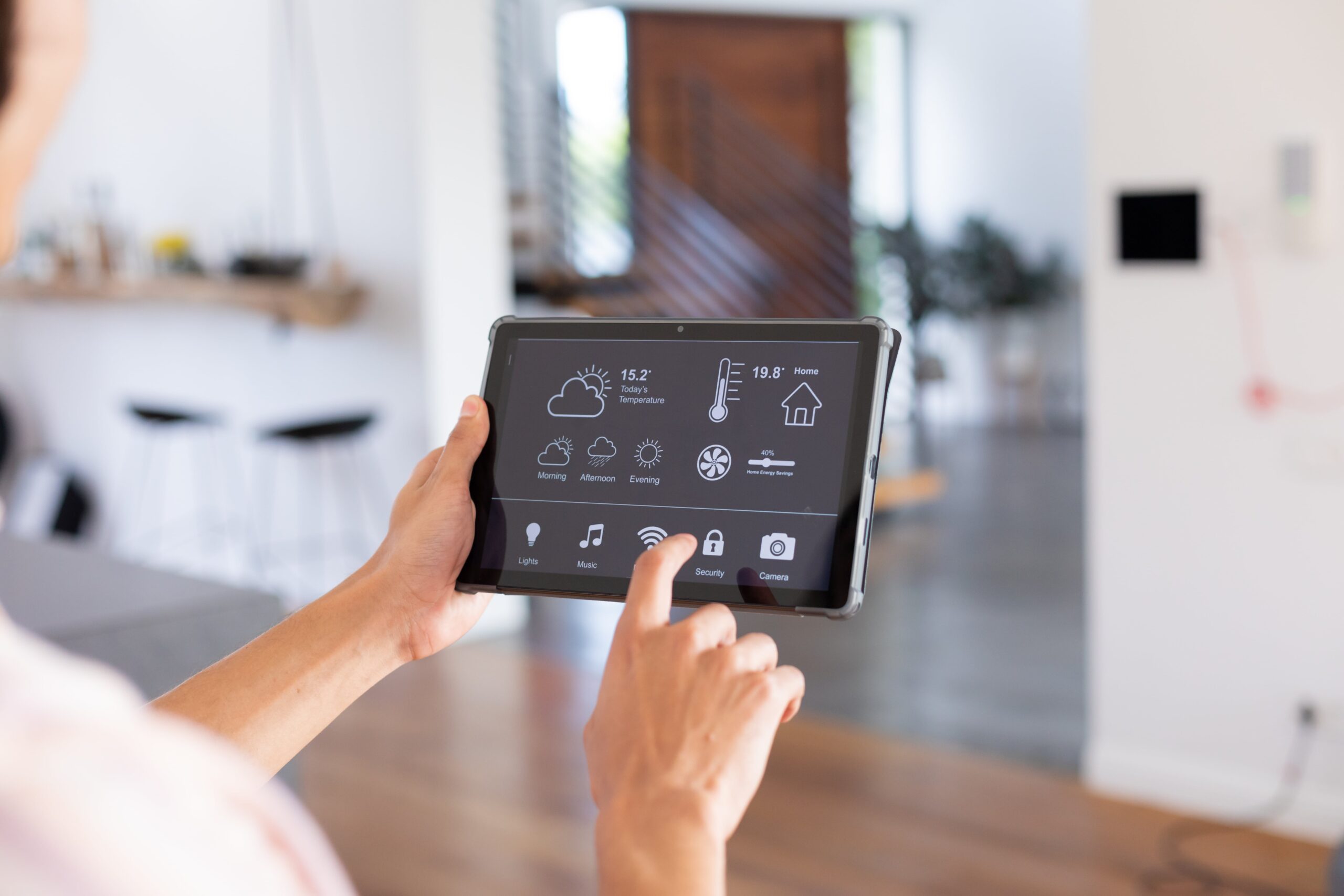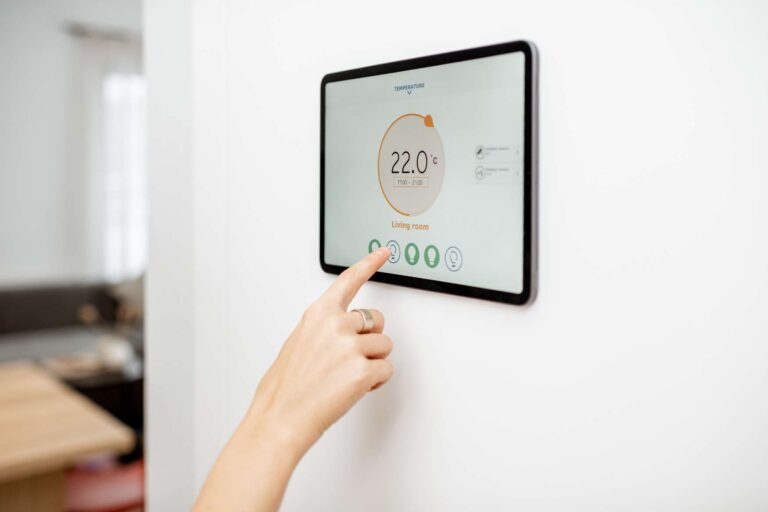
How To Design A Smart Home: Your Ultimate Guide
Welcome to our guide on designing a smart home. Whether you’re starting from scratch or upgrading your existing space, this article will show you how to create a connected, efficient, and comfortable living environment. We’ll explore how you can turn your house into a smart home that uses technology to make your daily life easier and more convenient.
Key Points for Smart Home Design
- Assess your needs and budget before starting
- Choose a central hub that works with many devices
- Focus on essential features like lighting and security first
- Ensure your home network is reliable and secure
- Set up automation to make daily tasks easier
- Look for ways to save energy and money
- Add new smart devices over time as needed
- Consider future compatibility and scalability
- Prioritize user-friendly interfaces for all family members
- Regularly update and maintain your smart home system
Your Smart Home System
Before getting smart home technology, it’s important to think about what you need and how much you can spend. Think about which parts of your home life you want to make easier or better. Common areas for smart homes include security, saving energy, lighting, and entertainment. Your budget will help you decide what features are most important and plan for adding more in the future.
When planning your system, think about how different devices will work together. Choose a main hub or system that works with lots of devices and will get updates for a long time. Popular options include smart home hubs from big tech companies or open systems that let you customize more if you’re good with technology. Think about how easy it is to use, if you can control it with your voice, and what devices will work with it when choosing your smart home system.

Understanding Smart Home Basics
A smart home is a setup where appliances and devices can be controlled remotely using the internet. These connected systems let you manage security, temperature, lighting, and entertainment easily. Smart home technology makes life more convenient, improves security, and can save energy. By connecting various smart devices and systems, you can create a home that fits your lifestyle, knows what you need, and makes living more comfortable and efficient.

Thermostats and Climate Control
Smart thermostats are really important for an efficient smart home. They learn what temperatures you like and adjust your home’s heating and cooling automatically. They can help use less energy by setting the right temperature based on your schedule, habits, and even how close you are to home. Some advanced models even check the weather forecast to make your home even more comfortable while using less energy. Many smart thermostats also show you how much energy you’re using, helping you find ways to save money on your bills.
Essential Smart Home Components
Smart Lighting Systems
Smart lighting is often an easy way to start making your home smarter. It can make your life better right away. These systems let you control your lights from anywhere, set schedules, and even change colors to match your mood or what you’re doing. Many smart bulbs are easy to put in and can help save energy by changing brightness based on natural light or turning off when no one’s in the room. Some advanced lights can even help you sleep better by matching your body’s natural rhythms.
Security and Surveillance
Smart security systems help you feel safe by letting you watch your home from anywhere, detecting movement, and sending you alerts right away. Smart cameras, video doorbells, and smart locks can all work together to protect your home in many ways. Advanced cameras with AI can tell the difference between people, animals, and cars, so you don’t get unnecessary alerts. Some systems can even recognize faces, so you know when specific family members come home.
Entertainment and Audio Systems
Make your living room feel like a movie theater with smart TVs, speakers, and streaming devices. Many of these can be controlled by your voice or phone, so you can easily manage your music and videos from anywhere in your home. Multi-room audio systems let you play the same music throughout your house or different music in different rooms. Smart entertainment systems can also work with other parts of your smart home, like automatically dimming lights when you start a movie or pausing when someone rings the doorbell.
Connectivity and Network Infrastructure
A strong Wi-Fi network is super important for any smart home. It’s like the nervous system that connects all your devices. Make sure your router can handle lots of connected devices at once. For bigger homes, you might need a mesh Wi-Fi system to cover all areas. Some smart home devices might need a wired connection to work best, so plan your network carefully, maybe including Ethernet cables in important parts of your home.
When setting up your smart home network, don’t forget about security. Use strong, unique passwords for all devices and your Wi-Fi. Turn on the best encryption available (like WPA3), and regularly update your devices to stay safe from hackers. Think about setting up a separate network for guests and less secure devices to keep them away from your main network. You can also use tools that watch your network and tell you if something unusual is happening.
Smart Home Automation
The real power of a smart home comes from automation, which can make your daily life much easier by doing routine tasks for you and making your home respond to your needs. You can create routines that do multiple things with one command or at certain times, making your home work the way you live. For example, you could set up a “Good Morning” routine that opens the blinds, turns on the lights, starts the coffee maker, and tells you about your day’s schedule. More advanced setups can use sensors and AI to learn your habits, like automatically adjusting the temperature when you’re on your way home from work.
Controlling things with your voice is another cool part of smart home automation . It’s convenient and makes things accessible. Voice assistants like Amazon Alexa, Google Assistant, or Apple’s Siri can help you manage your smart home easily, from changing the temperature to locking doors or even ordering groceries. Just remember to set up voice recognition and use good security so only people you trust can control your devices. You can even create custom voice commands for complex routines, making it even easier to interact with your smart home system.
Energy Management and Efficiency
Smart homes can use a lot less energy, which is good for the environment and can save you money. Use smart meters to see how much energy you’re using in real-time and find ways to use less. Many smart devices have features that save energy, like sensors that turn off lights in empty rooms or smart power strips that stop devices from using power when they’re not being used. By connecting these devices to your home’s automation system, you can create smart ways to save energy without making your home less comfortable.
If you have or want to get solar panels, smart home technology can help you use them better and get more for your money. For example, you could set your smart appliances to run when your solar panels are making the most power, so you use less electricity from the grid. Some systems can even predict how much solar power you’ll make based on the weather forecast and adjust how your home uses energy. Smart battery storage systems can also manage power smartly, storing extra energy to use when electricity prices are high or during power outages.
Smart Home Security Features
Make your home safer with smart locks that let you control who can enter your home from anywhere and keep track of who comes and goes. These locks can work with your smartphone, so you can give temporary access to guests or service people without needing to give them physical keys. Video doorbells let you see and talk to visitors even when you’re not home, adding extra security and convenience. Motion sensors can send alerts and turn on cameras or lights when they detect unexpected movement, which can scare away potential intruders and warn you early if something’s wrong.
For complete security, think about connecting these devices to a professional monitoring service. This can give you extra protection and peace of mind, with trained people ready to respond to alerts and call emergency services if needed. Advanced smart security systems can also work with other parts of your smart home, like automatically turning on lights or adjusting the temperature when the security system is turned off, making it easy to switch between “away” and “home” modes.
Entertainment and Media Integration
Create a smooth entertainment experience by connecting your smart TV, streaming devices, and audio systems. Multi-room audio systems let you play music throughout your home or in specific areas, creating the perfect mood for any occasion. With home theater automation, you can set up the perfect movie-watching environment with one command, automatically adjusting lights, temperature, and sound settings. You could even add smart lighting that syncs with what you’re watching to make it feel more immersive.
Voice control can make your entertainment setup even better, letting you search for content, control playback, and change settings without needing a remote. Some systems can even suggest content based on what you like to watch. For gamers, smart home integration can optimize your setup by automatically adjusting lighting, activating noise-cancelling features, or even setting up game-specific profiles on your smart devices.
Smart Kitchen and Appliances
The kitchen is another place where smart technology can make a big difference, making cooking easier and helping you manage your food better. Smart appliances like refrigerators with cameras inside can help you keep track of groceries, even letting you check what’s in your fridge while you’re at the store. Connected ovens let you preheat and watch your cooking from anywhere, so you can make perfect meals even when you’re busy doing other things. Voice-controlled cooking assistants can help you find recipes, set timers, and even control compatible appliances, making cooking more fun and accessible.
Comfort and Convenience Features
Smart blinds and curtains can adjust automatically based on the time of day or how much sunlight there is, helping keep your home comfortable and protecting your furniture from sun damage. These can work together with your smart lighting and heating/cooling systems to make your home comfortable and save energy throughout the day. Robot vacuums and mops can keep your floors clean without you having to do much work. Some models can even map your home to clean more efficiently and empty their own dustbins.
In the bedroom, smart mattresses and sleep trackers can help you sleep better by adjusting temperature and firmness based on what you like and how you sleep. These devices can give you detailed information about your sleep patterns, helping you find ways to sleep better. Some systems can even work with other smart home features, like slowly increasing light levels or starting your coffee maker as you start to wake up, making waking up more natural and pleasant.
Future Proofing Your Smart Home
As you design your smart home, think about how it can grow and change in the future to make sure your investment stays valuable for a long time. Choose devices and systems that can grow with your needs and work with new technologies as they come out. Look for products that support open standards and get regular software updates and long-term support. Consider saving some money in your budget for new technologies that might become important soon, like devices that use 5G or advanced AI.
Stay informed about new smart home standards and protocols to make sure your system stays compatible and up-to-date. Keep an eye on developments in areas like Matter, a new smart home standard that aims to make devices from different manufacturers work better together. Regularly check your smart home setup and be ready to upgrade or replace parts as needed to keep everything working well and securely. By thinking ahead when designing your smart home, you can create a system that not only meets your needs now but is also ready to adapt to future innovations in home automation technology.
Conclusion
Designing a smart home is an exciting project that can make your daily life much better, offering a mix of convenience, efficiency, and comfort. By carefully planning your system, choosing the right parts, and focusing on how everything works together and automates tasks, you can create a home that’s not only more convenient and efficient but also safer and more comfortable. The key to success is understanding what you need, staying informed about the latest technologies, and creating a system that fits your lifestyle.
Remember to start small and grow your smart home system over time. This approach lets you learn and adjust as you go, making sure your smart home really meets your needs and preferences. As you get more comfortable with the technology, you can explore more advanced features and connections, always improving your smart home experience. With the right setup, your smart home can provide years of convenience, comfort, and peace of mind, changing how you interact with your living space and making your overall quality of life better.
As smart home technology keeps improving quickly, there are endless possibilities for creating a truly intelligent living space. By following this guide and staying informed about new developments, you’ll be well on your way to designing a smart home that works for you today and adapts to your changing needs in the future. Enjoy the journey of creating your perfect smart home, and enjoy the benefits of a more connected, efficient, and comfortable living environment. If you need help in setting up a smart home, contact Ace Maintenance Dubai.




